Science
G N Ramachandran: The Great Indian Scientist And Vedantin
Aravindan Neelakandan
Apr 07, 2018, 07:05 PM | Updated 07:05 PM IST
Save & read from anywhere!
Bookmark stories for easy access on any device or the Swarajya app.
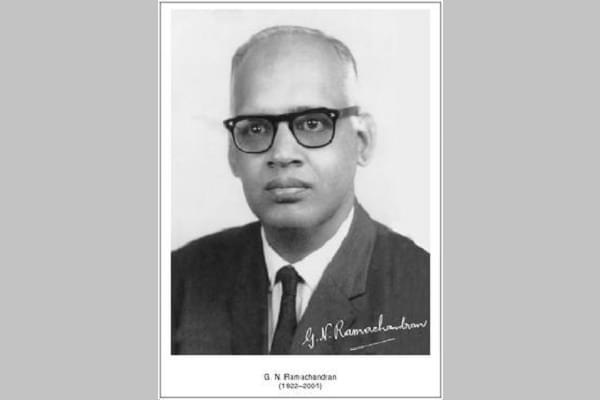
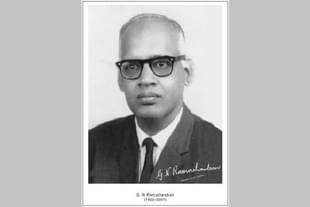
An auspicious morning is one when you see a tweet like this from the Science and Technology Minister Dr Harsh Vardhan on one of the greatest and yet least sung savants of science in India – Professor G N Ramachandran.
Remembering Biophysicist G.N. Ramachandran, one of those few scientists who have made India proud by their research; in the league of Sir CV Raman, Meghnad Saha, SN Bose. Ramachandranâs research was deep-rooted in ancient Indian philosophy. @DSTIndia pic.twitter.com/TmGLihAdzI
— Dr. Harsh Vardhan (@drharshvardhan) April 7, 2018
One is thankful to the minister for reminding the nation of this great scientist. In Chennai, where there are ample statues of all sorts of political demagogues, Ramachandran is remembered through an almost nondescript building inside Madras University – perhaps symbolic of our failings.
Life of biophysicist Ramachandran is as inspiring as it is melancholic. Of course, his research was not rooted in Indian philosophy as such. But he was interested in building an Indic approach to the philosophy of science. To that, we shall come later.
That Ramachandran was a brilliant physicist with great potential for contribution to global science was recognised by then vice-chancellor of Madras University, Lakshmanaswamy Mudaliar. After all, it was physicist C V Raman who had recommended the young physicist in his place when Mudaliar wanted the veteran physicist for Madras University.
That’s how Ramachandran ended up in Madras University, where he became the founder and head of the physics department at the early age of 29. Mudaliar treated him as his son and made sure that there were neither administrative nor financial constraints to the work of Ramachandran, writes professor M Vijayan, INSA Albert Einstein Research Professor.
Till 1969, the year Mudaliyar retired, Ramachandran had no problem in doing his research in Madras. But after that, his life became a tale of two cities as he shuttled between Madras and Bangalore.
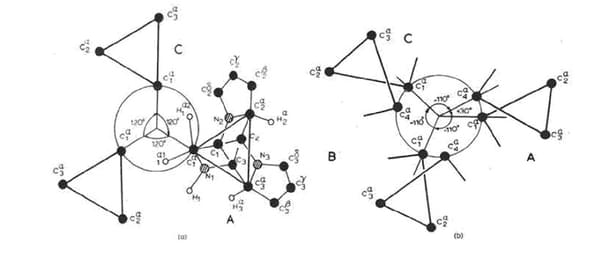
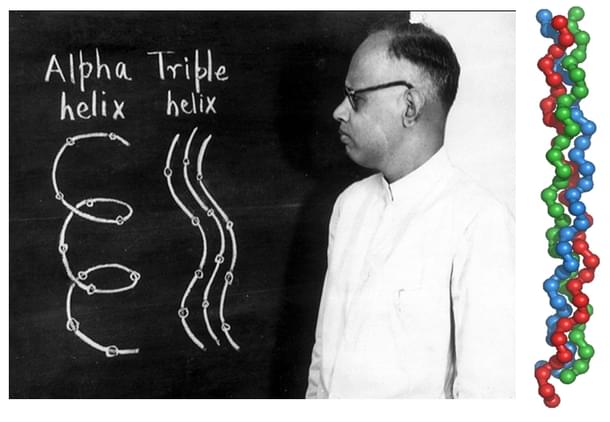
Ramachandran put Madras on the map of Indian science when he, along with Gopinath Kartha, proposed the triple helix structure for the collagen molecule. The work was published in Nature magazine in 1955. He co-authored this paper with Kartha. Co-discoverer of the structure of the DNA molecule, Francis H C Crick, however, opposed the proposed structure saying that though the “idea” was “basically correct”, “the actual structure suggested by them to be wrong”. But the model, now famous as the ‘Madras triple helix model’, was vindicated, though Ramachandran was never given his rightful place of honour for the discovery.
Though the initial objections raised on the surface against the proposed structure looked scientific, that there was also prejudice at work, cannot be discounted. Biophysicist professor Vijayan explains:
When the comparatively unknown Ramachandran, working in a scientifically obscure corner, entered the collagen field, to some it might have appeared to be a case of fools rushing in where angels fear to tread. In the event when Ramachandran and Kartha came out with essentially the correct structure, there was considerable hesitation in giving them the credit for this splendid discovery. The minor points of disagreement were often presented in such a way as to imply that the model proposed by Ramachandran was wrong. In retrospect, even the controversy regarding the number of inter-chain hydrogen bonds appears somewhat meaningless. .... In recent years, many crystal structures of oligo-peptides incorporating collagen-like and indeed natural collagen sequences have been solved. These structures confirm the Ramachandran model of collagen, including the water bridge, as often involving hydroxyproline.M Vijayan, ‘Biophysics and Structural Biology in India’ in From Physiology and Chemistry to Biochemistry (Edited by D P Burma & Maharani Chakravorty), Pearson Education India, 2011
Ramachandran eventually moved from the collagen work to what became one of the most important contributions to the field of biophysics. Today it is known as the Ramachandran plot.
Dr Chaitanya Giri, astromaterials and planetary scientist with Earth Life Science Institute (ELSI) points out in his tweet in honour of Ramachandran, how as a biophysicist he was fascinated by the “simplicity of a 2D graphical Ramachandran plot in describing the 3D protein structures”.
Being a biophysicist by training, I always was fixated by the simplicity of a 2D graphical Ramachandran Plot in describing the 3D protein structures. G.N. Ramachandran is one of the most impactful figures of modern biosciences. Read. https://t.co/y1Ilv8EJsS https://t.co/jK3bonE8BW
— Dr. Chaitanya GIRI (@girichaitanya19) April 7, 2018
There was a Vedantist deep inside Ramachandran, the scientist. His biographer Raghupathy Sarma points out:
In one MATPHIL Report, Ramachandran elaborated on ... interesting paradox from the ancient Hindu philosophy used to describe the Divine Force of the Universe in Kena Upanishad: “If you think you know It, then you do not know It, and if you know that you cannot know It, then you know it.” This statement conveys perpetual doubt and indefiniteness.
He was fascinated by Syadvada and Saptabhangi of Jain philosophy. In 1982, he wrote a paper in the journal Current Science, depicted below.
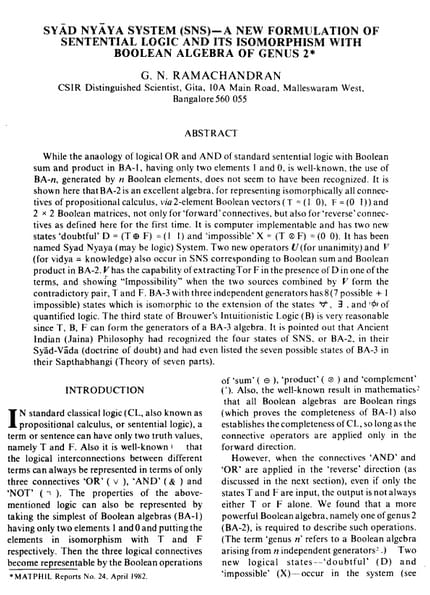
It is interesting to see that Ramachandran, who used mathematics in biological problems, was also inspired in the same way as did many Indian mathematicians, like Ramanujan, who saw himself looking into the divinity through mathematics. One can deduce from the passage (below) which he had written for his ‘Vedanta and Epistemology’, that his search for mathematical models to understand reality stems from a deep civilisational conviction of seeing mathematics as an expression of Brahman itself.
There is a close analogy of these ideas of modern logical analysis with the concepts in Indian philosophy of the ‘Infinite’ (ananta) which is one of the attributes of Brahman (absolute Reality). The Upanishads contain many statements to the effect that this Reality has contradictory properties ... The logical similarity to the example of infinity in mathematics is very close. In the case of mathematical infinity, we have to say that although it is a number, it does not belong to the class of finite numbers, and therefore it can have contradictory properties such as being both greater than and smaller than itself.Vedanta and Modern Epistemology, 1989
It is amazing to see the continuity in Indian thought in the domain of scientific approach to reality. More than eight centuries before Ramachandran, celebrated mathematician Bhaskaracharya, expressing the paradoxical nature of the concept of infinity, said that there was no change in khahara (term for infinity) by addition or subtraction, and likened it to the divine being unaltered by the appearance of entities coming into existence and leaving at the time of universal cycles of creation and dissolution (Bija-Ganita 2:20).
So, what is the legacy of Ramachandran? Perhaps the words of Vijayan summarise the achievements of the life of this seer – a life that was incredibly great in the annals of science:
G.N.Ramachandran is among the founding fathers of structural molecular biology. He made pioneering contributions in computational biology, modelling and what we now call bioinformatics. The triple helical coiled coil structure of collagen proposed by him forms the basis of much of collagen research at the molecular level. The Ramachandran map remains the simplest descriptor and tool for validation of protein structures. He has left his imprint on almost all aspects of biomolecular conformation. His contributions in the area of theoretical crystallography have been outstanding. His legacy has provided inspiration for the further development of structural biology in India.
Forgotten by Tamil Nadu, Ramachandran nevertheless put the name of Madras honourably on the atlas of world science. A fallen Tamil Nadu is unable to remember the greatness of its great son. Once again, thanks Dr Vardhan for remembering this man.
Aravindan is a contributing editor at Swarajya.




